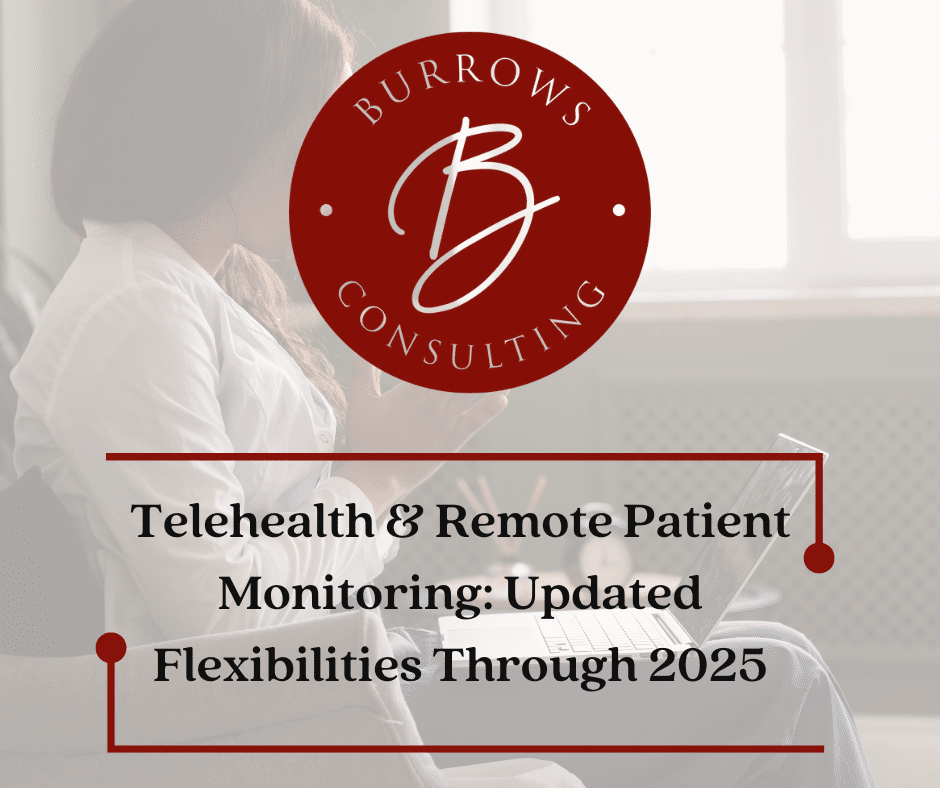The COVID-19 public health emergency (PHE) highlighted the need for telehealth flexibilities, allowing patients to receive care safely from home and expanding access to remote services. These temporary flexibilities have been extended for RHCs, FQHCs, and Medicare providers through December 31, 2025, with certain requirements resuming for behavioral telehealth starting January 1, 2026.
Telehealth allows providers to substitute in-person visits with two-way, interactive technology for evaluation, management, and monitoring. During the COVID-19 PHE, emergency waivers and regulatory flexibilities expanded access to telehealth, including the ability to use the patient’s home as an originating site and to conduct audio-only visits when necessary.
Key Updates for Telehealth & Remote Patient Monitoring
- Originating Site: Patients’ homes qualify as originating sites through December 31, 2025. This applies to RHCs and FQHCs as distant sites providing telehealth services.
- Audio-Only Telehealth: Non-behavioral and non-mental health visits may use audio-only technology. Behavioral and mental health visits also allow audio-only communications for patients at home.
- RHC/FQHC Billing: Providers can bill for telehealth services using HCPCS code G2025, including services furnished via audio-only technology through December 31, 2025.
- Behavioral Telehealth In-Person Visits: The requirement for in-person visits for behavioral telehealth will resume on January 1, 2026.
- Acute Hospital Care at Home: Hospitals may continue to deliver inpatient services at home using telehealth.
- Hospice Care Recertification: Telehealth may be used for hospice eligibility recertification.
Telehealth Flexibilities-Quick Reference for RHCs & FQHCs
| Flexibility | Description | Expiration Date |
| Originating Site Expansion | Patient’s home qualifies as the originating site. | Dec 31, 2025 |
| Audio-Only Visits | Allowed for non-behavioral and non-mental health telehealth services. | Dec 31, 2025 |
| Provider Eligibility | Expanded list of Medicare providers eligible to furnish telehealth. | Dec 31, 2025 |
| Hospice Recertification | Telehealth can be used for hospice eligibility recertification. | Dec 31, 2025 |
| Behavioral Telehealth In-Person Visit | Suspended until Jan 1, 2026. | Jan 1, 2026 |
| Acute Hospital Care at Home | Waiver program allowing hospital-level care at home. | Dec 31, 2025 |
| RHC/FQHC Telehealth Billing (G2025) | Bill for eligible telehealth services via HCPCS G2025, including audio-only. | Dec 31, 2025 |
| Removed Code – CPT® 98016 | Now classified as Communication Technology-Based Service (CTBS), not Medicare telehealth. | N/A |
Remote Patient Monitoring (RPM)
RPM allows patients to collect their own health data via connected devices (e.g., blood pressure monitors) and transmit it securely to providers for ongoing treatment management. RPM encompasses:
- Patient Education & Device Setup – Teaching patients to use the device correctly.
- Device Supply & Connectivity – Ensuring devices are connected and transmitting data.
- Treatment Management – Providers reviewing data to optimize care.
RPM Billing Highlights are available on page 11 of the MLN901705 Telehealth & Remote Patient Monitoring Booklet, April 2025
Takeaways
- Telehealth and RPM flexibilities remain in effect through December 31, 2025, supporting patient care at home, audio-only visits, and expanded provider eligibility.
- RHCs and FQHCs can continue to bill for services using G2025.
- In-person visits for behavioral telehealth resume January 1, 2026, marking the return to pre-PHE requirements for these services.
- Providers should continue documenting telehealth and RPM usage in the patient’s medical record to support care management and compliance.
For the latest Medicare guidance, refer to the MLN901705 Telehealth & Remote Patient Monitoring Booklet, April 2025, and check the Remote Patient Monitoring webpage
Contact Melissa Jones, CRHCP for Rural Health expertise or visit our contact page.

0 comments to " Telehealth & Remote Patient Monitoring: Updated Flexibilities Through 2025 "